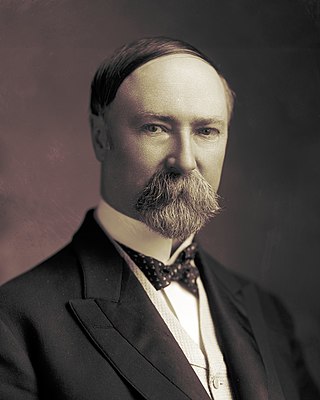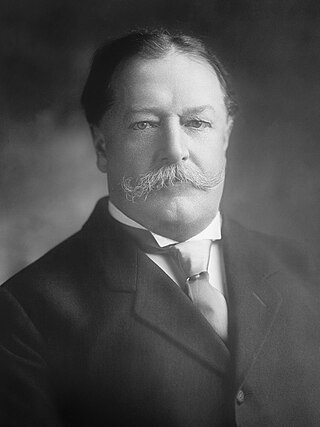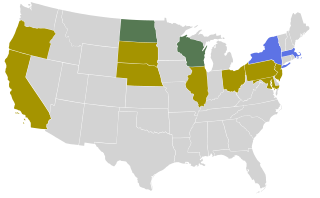Related Research Articles

Theodore Roosevelt Jr., often referred to as Teddy or by his initials, T. R., was an American politician, statesman, conservationist, naturalist, and writer who served as the 26th president of the United States from 1901 to 1909. He previously held various positions in New York politics, rising up the ranks to serve as the state's 33rd governor for two years. He later served as the 25th vice president under president William McKinley for six months in 1901, assuming the presidency after McKinley's assassination. As president, Roosevelt emerged as a leader of the Republican Party and became a driving force for anti-trust and Progressive policies.

William Howard Taft was the 27th president of the United States, serving from 1909 to 1913, and the tenth chief justice of the United States, serving from 1921 to 1930, the only person to have held both offices. Taft was elected president in 1908, the chosen successor of Theodore Roosevelt, but was defeated for reelection in 1912 by Woodrow Wilson after Roosevelt split the Republican vote by running as a third-party candidate. In 1921, President Warren G. Harding appointed Taft to be chief justice, a position he held until a month before his death.

The 1908 United States presidential election was the 31st quadrennial presidential election, held on Tuesday, November 3, 1908. Republican Party nominee William Howard Taft defeated three-time Democratic nominee William Jennings Bryan.

The 1912 United States presidential election was the 32nd quadrennial presidential election, held on Tuesday, November 5, 1912. Democratic Governor Woodrow Wilson of New Jersey unseated incumbent Republican President William Howard Taft while defeating former President Theodore Roosevelt and Socialist Party nominee Eugene V. Debs.

William Jennings Bryan was an American lawyer, orator, and politician. Beginning in 1896, he emerged as a dominant force in the Democratic Party, running three times as the party's nominee for President of the United States in the 1896, 1900, and 1908 elections. He served in the House of Representatives from 1891 to 1895 and as the Secretary of State under Woodrow Wilson from 1913 to 1915. Because of his faith in the wisdom of the common people, Bryan was often called "the Great Commoner", and because of his rhetorical power and early fame as the youngest presidential candidate, "the Boy Orator".

Charles Warren Fairbanks was an American politician who served as a senator from Indiana from 1897 to 1905 and the 26th vice president of the United States from 1905 to 1909. He was also the Republican vice presidential nominee in the 1916 presidential election. Had the Republican ticket been elected, Fairbanks would have become the third vice president to multiple presidents, after George Clinton and John C. Calhoun.

Alton Brooks Parker was an American judge. He was the Democratic nominee in the 1904 United States presidential election, losing in a landslide to incumbent Republican Theodore Roosevelt.

The Progressive Era (1896–1917) was a period in the United States during the early 20th century of widespread social activism and political reform across that country that focused on defeating corruption, monopoly, waste, and inefficiency. The main themes ended during American involvement in World War I (1917–1918) while the waste and inefficiency elements continued into the 1920s. Progressives sought to address the problems caused by rapid industrialization, urbanization, immigration, and political corruption; and by the enormous concentration of industrial ownership in monopolies. They were alarmed by the spread of slums, poverty, and the exploitation of labor. Multiple overlapping progressive movements fought perceived social, political and economic ills by advancing democracy, scientific methods, professionalism and efficiency; regulating businesses, protecting the natural environment, and improving working conditions in factories and living conditions of the urban poor. Spreading the message of reform through mass-circulation newspapers and magazines by "probing the dark corners of American life" were investigative journalists known as "muckrakers". The main advocates of progressivism were often middle-class social reformers.

Charles Nathaniel Haskell was an American lawyer, oilman, and politician who was the first governor of Oklahoma. As a delegate to Oklahoma's constitutional convention in 1906, he played a crucial role in drafting the Oklahoma Constitution and gaining Oklahoma's admission into the United States as the 46th state in 1907. A prominent businessman in Muskogee, he helped the city grow in importance. He represented the city as a delegate in both the 1906 Oklahoma convention and an earlier convention in 1905 that was a failed attempt to create a U.S. state of Sequoyah.

The Constitution of California is the primary organizing law for the U.S. state of California, describing the duties, powers, structures and functions of the government of California. California's constitution was drafted in both English and Spanish by American pioneers, European settlers, and Californios and adopted at the 1849 Constitutional Convention of Monterey, following the American Conquest of California and the Mexican–American War and in advance of California's Admission to the Union in 1850. The constitution was amended and ratified on 7 May 1879, following the Sacramento Convention of 1878–79.
The Constitution of the State of Ohio is the basic governing document of the State of Ohio, which in 1803 became the 17th state to join the United States of America. Ohio has had three constitutions since statehood was granted.

The 1912 Republican National Convention was held at the Chicago Coliseum, Chicago, Illinois, from June 18 to June 22, 1912. The party nominated President William H. Taft and Vice President James S. Sherman for re-election for the 1912 United States presidential election.

The Progressive Party was a third party in the United States formed in 1912 by former president Theodore Roosevelt after he lost the presidential nomination of the Republican Party to his former protégé turned rival, incumbent president William Howard Taft. The new party was known for taking advanced positions on progressive reforms and attracting leading national reformers. The party was also ideologically deeply connected with America's radical-liberal tradition.

The Constitution of the State of Oklahoma is the governing document of the U.S. State of Oklahoma. Adopted in 1907, Oklahoma ratified the United States Constitution on November 16, 1907, as the 46th U.S. state. At its ratification, the Oklahoma Constitution was the lengthiest governing document of any government in the U.S. All U.S. state constitutions are subject to federal judicial review; any provision can be nullified if it conflicts with the U.S. Constitution.

The Fourth Party System was the political party system in the United States from about 1896 to 1932 that was dominated by the Republican Party, except the 1912 split in which Democrats captured the White House and held it for eight years.
In the United States, term limits restrict the number of terms of office an officeholder may serve. At the federal level, the president of the United States can serve a maximum of two four-year terms, limited by the 22nd Amendment to the United States Constitution. Some State government offices are also term-limited, including executive, legislative, and judicial offices.

The presidency of William Howard Taft began on March 4, 1909, when William Howard Taft was inaugurated as 27th president of the United States, and ended on March 4, 1913. Taft was a Republican from Ohio. The protégé and chosen successor of President Theodore Roosevelt, he took office after easily defeating Democrat William Jennings Bryan in the 1908 presidential election. His presidency ended with his defeat in the 1912 election by Democrat Woodrow Wilson.

From January 23 to June 4, 1912, delegates to the 1912 Republican National Convention were selected through a series of primaries, caucuses, and conventions to determine the party's nominee for President in the 1912 election. Incumbent President William Howard Taft was chosen over former President Theodore Roosevelt. Taft's victory at the national convention precipitated a fissure in the Republican Party, with Roosevelt standing for the presidency as the candidate of an independent Progressive Party, and the election of Democrat Woodrow Wilson over the divided Republicans.

The 1912 Progressive National Convention was held in August 1912. Angered at the renomination of President William Howard Taft over their candidate at the 1912 Republican National Convention, supporters of former President Theodore Roosevelt convened in Chicago and endorsed the formation of a national progressive party. When formally launched later that summer, the new Progressive Party acclaimed Roosevelt as its presidential nominee and Governor Hiram Johnson of California as his vice presidential running mate. When questioned by reporters, Roosevelt said he felt as strong as a "bull moose". Henceforth known as the "Bull Moose Party", the Progressives promised to increase federal regulation and protect the welfare of ordinary people.

The 1908 U.S. Presidential election occurred in the backdrop of the Progressive achievements of U.S. President Theodore Roosevelt's second term as well as against the U.S. recovery following the Panic of 1907. In this election, Roosevelt's chosen successor, Republican William Howard Taft, ran in large part on Roosevelt's Progressive legacy and decisively defeated former Congressman and three-time Democratic U.S. Presidential candidate William Jennings Bryan. Overall, the 1908 presidential campaign and election were about labor issues, trusts, campaign finance reform, imperialism, and corruption.
References
- ↑ Library, Ohio State (1913). Organic Law of Ohio and Proposed Amendments: Or, Helps to Constitution Makers. F. J. Heer printing Company.
- ↑ "The 1912 Constitutional Convention – Teaching Cleveland Digital". 23 December 2011.
- ↑ Documents, Library of Congress Division of (1915). Monthly Check-list of State Publications. Division of Documents.
- ↑ Reed, Thomas Harrison (1926). A Constitutional Convention in 1927?. Bureau of governmental research.
- ↑ Curtin, Mike (31 July 2023). "From home rule to the initiative itself, Ohio would have never won many reforms under a 60% rule • Ohio Capital Journal". Ohio Capital Journal.
- ↑ Steinglass, Steven H.; Scarselli, Gino J. (2022). The Ohio State Constitution. Oxford University Press. ISBN 978-0-19-761972-8.
- ↑ "A Charter of Democracy".
- ↑ Chace, James (24 November 2009). 1912: Wilson, Roosevelt, Taft and Debs -The Election that Changed the Country. Simon and Schuster. ISBN 978-1-4391-8826-2.
- ↑ Roosevelt, Theodore (31 March 2023). "A Charter of Democracy: Teddy Roosevelt's speech to the 1912 Ohio Constitutional Convention • Ohio Capital Journal". Ohio Capital Journal.
- ↑ Betti, Tom; Sauer, Doreen Uhas; Foundation, Columbus Landmarks (2013-05-21). On This Day in Columbus, Ohio History. Arcadia Publishing. ISBN 978-1-62584-574-0.
- ↑ Bryan, William Jennings (12 July 2023). "The People's Law: William Jennings Bryan's speech to the 1912 Ohio Constitutional Convention • Ohio Capital Journal". Ohio Capital Journal.